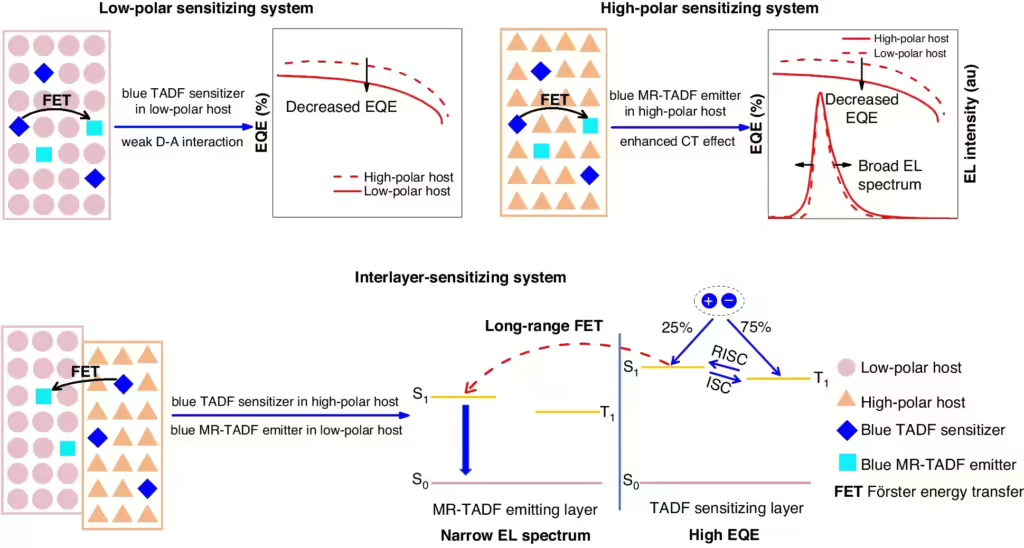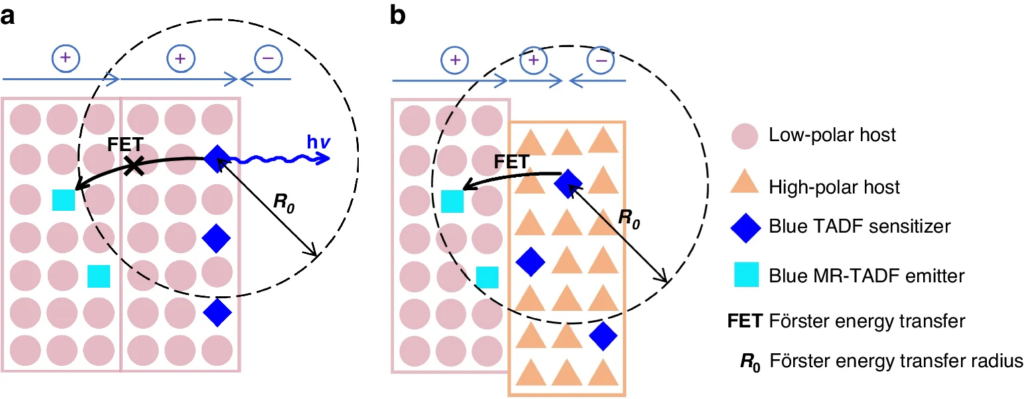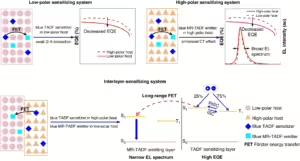Hyperfluorescence OLEDs are a type of organic light-emitting diode (OLED) technology that combines the high efficiency of Thermally Activated Delayed Fluorescence (TADF) with the high color purity of fluorescent emitters. This technology leverages the advantages of TADF materials, which can harness both singlet and triplet excitons for light emission, significantly improving the efficiency compared to traditional fluorescent OLEDs. TADF materials are like having two energy sources instead of one, making the light production process much more effective and efficient. Hyperfluorescence OLEDs use a TADF material as a sensitizer that transfers energy to a fluorescent emitter, resulting in light emission with superior color quality and efficiency.

Professor Zujin Zhao and his research team at the South China University of Technology have been working on enhancing the performance of blue MR-TADF (Multi-Resonance Thermally Activated Delayed Fluorescence) emitters for OLEDs. Blue MR-TADF materials are known for their narrow electroluminescence (EL) spectra, making them suitable for high-color-quality displays. However, these materials often have a problem called quenching, where some of the energy that should produce light gets lost instead. This happens when the triplet energy states (one of the two energy sources TADF materials use) interfere with the light production process. This ends up with the efficiency of the light getting worse, especially at higher brightness levels. The decrease in performance at higher levels is known as efficiency roll-off.
The researchers introduced a novel interlayer sensitization strategy, which separates the TADF sensitizer and the MR-TADF emitter into two adjacent emitting layers (EMLs) with different host materials, differing from the traditional co-doping strategy. This separation facilitates long-range Förster energy transfer (FET) from the TADF sensitizer to the MR-TADF emitter, improving energy transfer efficiency and mitigating issues caused by triplet quenching. The interlayer sensitization strategy optimizes the energy transfer process and accommodates the different polarity requirements of the blue TADF sensitizer and blue MR-TADF emitter, enhancing overall electroluminescence (EL) efficiency while maintaining high color purity.
The researchers successfully fabricated high-performance blue hyperfluorescence OLEDs using various blue MR-TADF emitters and TADF sensitizers, achieving outstanding external quantum efficiencies (EQEs) of up to 38.8%, a significant improvement compared to unsensitized devices. This study demonstrates the potential of the interlayer sensitization strategy for constructing high-performance blue hyperfluorescence OLEDs. The results highlight the strategy’s effectiveness in producing blue OLEDs with high EL efficiency and color purity, paving the way for future advancements in OLED technology.

I have to dumb this down for myself, but it seems like the researchers have developed a new method to improve blue OLED by separating the components responsible for light production into two layers, allowing them to work more efficiently together. This method uses a special energy transfer process to optimize how these layers interact, resulting in brighter and more color-pure blue light. Like most of the challenges with making any kind of LED, it ends up being a process where the scientists have to find the most efficient way for energy to be transferred within a diode to create efficiencies, and hence brightness and clarity.
Reference
Wang, J., Zou, P., Chen, L. et al. Promising interlayer sensitization strategy for the construction of high-performance blue hyperfluorescence OLEDs. Light Sci Appl 13, 139 (2024). https://doi.org/10.1038/s41377-024-01490-6

